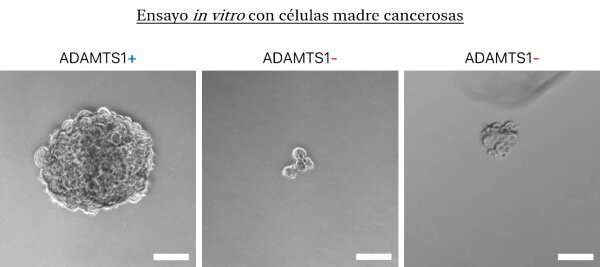
Scientists from the University of Granada and GENYO (Pfizer-University of Granada-Andalusian Government Centre for Genomics and Oncological Research), in a study led by Juan Carlos Rodríguez-Manzaneque, have demonstrated the significant role of a protein called ADAMTS1 in uveal melanoma, one of the rarest and most aggressive cancers that exist, which develops in the eye.
Tumors are composed not only of a mass of cells that grow uncontrollably but also of the environment they create during their growth—together creating what is known as the ‘tumor microenvironment.” Within this environment, there are proteins that remodel it, known as extracellular proteases, which are capable of inhibiting or contributing to tumor growth and metastasis. They do this by modifying non-cellular elements of the tumor microenvironment that form the so-called extracellular matrix.
In this study, published in the journal Cancers, the researchers studied the role that one of these proteases, ADAMTS1, plays in the development of a rare and highly-aggressive subtype of melanoma: uveal melanoma. Uveal melanoma develops in the eye, although 50% of patients develop metastasis, and it has an incidence of 2–8 cases per million inhabitants in Europe
“In this research, we demonstrated that the ADAMTS1 protease is necessary for cancer cells to mimic endothelial cells (responsible for forming blood vessels), which is related to more aggressive tumors and a worse clinical prognosis,” explains Carlos Peris Torres, the main author of the work.
To do this, the researchers inhibited the ADAMTS1 protease using CRISPR/Cas9 gene-editing technology. This is a molecular tool used to ‘edit’ or ‘correct’ the genome of any cell (its developers, Emmanuelle Charpentier and Jennifer A. Doudna, having won this year’s Nobel Prize for Chemistry). The researchers then verified the outcomes of their intervention on the protease in in vitro models with cell lines, and in vivo with different mouse models.
Bioinformatic tools
In addition, using advanced bioinformatic tools and publicly-available data on uveal melanomas (from the Cancer Genome Atlas Project, developed by the US National Cancer Institute, which holds data on more than 20,000 samples of 33 different types of cancer), the UGR and GENYO scientists found new genes whose expression affects the clinical prognosis of this tumor type.
“These include several members of the ADAMTS family and endothelial genes such as CDH5 and KDR. A more detailed analysis also revealed a high expression of ADAMTS1 in the initial stages of uveal melanoma, which confirmed its contribution to the initiation of tumor development and corroborated the results obtained experimentally,” adds Peris Torres.
Source: Read Full Article
